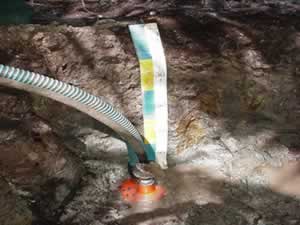Problem Soils: Managing Shallow Acid Sulfate Soils
[addw2p name=”problemSoils”]

Sedu
Acid sulfate soils are estimated to cover an area of about 110,000 ha in Peninsular Malaysia with at least 20,000 ha under oil palms (Poon and Bloomfield, 1977). These soils are characterised by very low pH values (< 3.5) and the presence of yellowish jarosite (Kfe3 (So4)2 (OH)6) mottles (Shamshuddin and Auxtero, 1991).
The problems with acid sulfate soils are:-
- they tend to be waterlogged in their natural state and must be drained before cultivation, and
- draining beyond the pyrite layer will generate excessive acidity which is detrimental to palm growth.
The latter is due to the oxidation of pysite to form sulphuric acid as shown below:

This oxidation also causes breakdown of clay minerals which releases Al, Mn and K into the soil solutions (Shamshuddin and Auxtero, 1991). The drop in pH to below 3.0 is not uncommon and the oil palms will suffer hyperacidity symptoms and poor yields Toh and Poon (1982) further, classified acid sulfate soils into 3 categories based on oil palm performances. Their severe category has acid layer at 0 to 60 cm while current soil classification in Malaysia tag it at 0 to 50 cm for shallow acid sulfate soils, such as Linau and Sedu series.
Hew and Khoo (1970) found that liming was generally ineffective to control acidity in acid sulfate soils. Poon and Bloomfield (1977) then showed that by creating anaerobic conditions, the reaction in equation (1) will not proceed and thus, preventing the generation of acidity. Since inadequate drainage will give rise to flooded conditions which also adversely affect palm performance, a balance has to be struck between over and under drainage.
This balance is achieved through a network of field, collection and main drains similar to those found in peat swamp as described earlier but their objective differs. The prime requirement in the management of acid sulfate soils is that the water-table should be maintained above the pepsitic layer for as long as possible. This is again carried out using stops, weirs and watergates, their numbers are largely determined by the depth to pysiritic layer and slope of the land. Normally, the water-table is maintained between 45 to 60 cm from the soil surface, hence, the depth of field drains should not exceed 75 cm. Otherwise, there is a risk of accelerated oxidation of the pyritic layer during dry weather conditions (Poon, 1983).
Another important aspect in the management of shallow acid sulfate soils is to provide for periodic flushing of the drains to remove the accumulated toxic polyvalent ions such as Al3+ and the extremely acidic water (Poon, 1983). Therefore, during the wet season, all the water retention blocks and watergates are opened to allow flushing. One to two flushing during the wet season are usually adequate. Before the end of the wet season, the blocks and watergates are again closed to allow fresh water to build up to the required level.
The other aspects of management of acid sulfate soils are similar to those of coastal non-acid sulfate soils. The success in using water control to manage oil palms on shallow acid sulfate soils is best illustrated by Figure 4.

